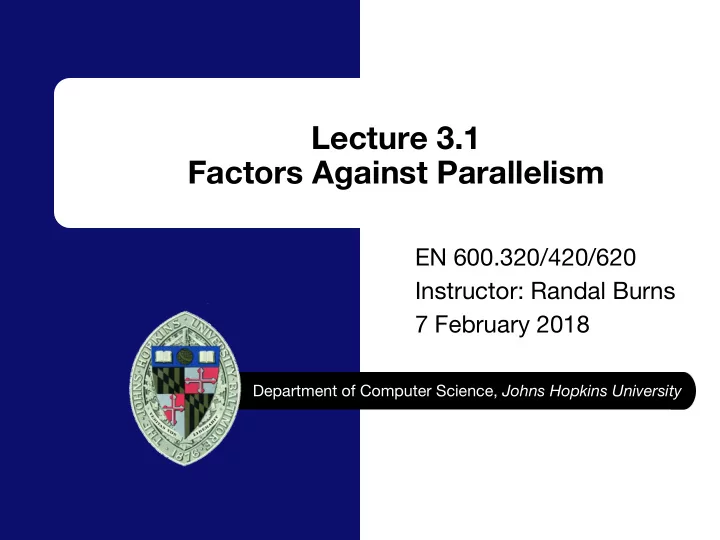

Lecture 3.1 Factors Against Parallelism EN 600.320/420/620 Instructor: Randal Burns 7 February 2018 Department of Computer Science, Johns Hopkins University
3 Factors Against Parallelism ● Startup costs associated with initiating processes May often overwhelm actual processing time (rendering ||ism useless) – Involve thread/process creation, data movement – ● Interference : slowdown resulting from multiple processors accessing shared resources Resources: memory, I/O, system bus, sub-processors – Software synchronization: locks, latches, mutex, barriers – Hardware synchronization: cache faults, HW mutexes and locks – ● Skew: when breaking a single task into many smaller tasks, not all tasks may be the same size Not all tasks finish at the same time – Lecture 4: Concepts in Parallelism
Example: Startup Costs ● Szkieletor in Krakow Poland Too expensive to – complete or demolish Image from http://en.wikipedia.org/wiki/File:Szkielet or2.jpg Lecture 4: Concepts in Parallelism
Example: Interference Image from http://crowdcentric.net/2011/05/can-you-help-us-solve-the-worlds-traffic-cong estion/ Lecture 4: Concepts in Parallelism
Example: Skew Airbus A350 waiting for the incomplete nose section http://www.ainonline.com/?q=aviation-news/dubai-air-show/2011-11-12/ Lecture 4: Concepts in Parallelism
Factors and Communication ● Real things that degrade parallelism I/O (memory and storage) – Network communication – Failures—particularly slow/failed processes – ● But, HPC community focuses on communication (among processes) as the major source This can be via memory or networking – I/O may be as important now: can be modeled as communication. – One way? Often bundled as startup costs. Lecture 4: Concepts in Parallelism
Communication ● Parallel computation proceeds in phases Compute (evaluate data that you have locally) – Communicate (exchange data among compute) – ● Communication is governed by: Latency: fixed cost to send a message – ● Round trip time (speed of light and switching costs) Bandwidth: marginal cost to send a message – ● Link capacity ● Latency dominates small messages and bandwidth dominates large Almost always better to increase message size for performance, but – difficult to achieve in practice Lecture 4: Concepts in Parallelism
Overlapped Communication ● Messaging and computation that occur in parallel are overlapped – Reduces wait time between computing phases – Best codes overlap Lecture 4: Concepts in Parallelism
Bulk Synchronous Parallel (BSP) ● A natural abstraction for parallel computation Used in most MPI and map/reduce programs – ● Three phases of processing per “superstep” Compute – Communication – Barrier – ● Allows for no overlap ● Cloud framework Hama – Lecture 4: Concepts in Parallelism
Amdahl’s Law and BSP ● Any area that is not blue contributes to the ‘sequential’ part of the code, i.e. unoptimized Communication – Barrier – Skew – Lecture 4: Concepts in Parallelism
Conclusions ● Factors against parallelism are the most important design consideration. This is the non-parallel part in Amdahl’s law – ● Typical experience Design a parallel code – Test on n=2 or 4 nodes (works great) – Deploy on >16 nodes (sucks eggs) – Measure factors against parallelism – Redesign/reimplement – Lecture 4: Concepts in Parallelism
Recommend
More recommend